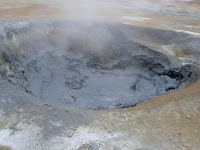
After visiting Gullfoss we realized we had gone too fast!. We had driven and seen what we were supposed to do in the comming 2-3 days!. Since it was still early and daylight (remember that during the summer it gets dark very late), we were not really convinced staying overnight in that area, so, after having looked several times at the map, we decided to head direction North.

We saw in the map that the Kjolur Route was marked as a gravel road, but we thought that going slowly we would manage with no problems to head our destination point: Akureyri. We were also almost sure we would find some settlement.
Adventure had started.

When we had already driven several kilometres through the route, we realized we had for sure, not enough gasoline to reach the other end of the road, but at that point of time we still had a hope to find some settlement, and a small gasoline station. I started desperately, looking at the map the guy at the airport gave us… no signal of any gasoline station, shop or anything similar. Still on the book guide it mentioned one place ... somewhere on the way.... there was a small “hut”, but so far no signal.

Hours were passing by. We were already going next to the Langjokull, and nothing, but still was day light, so we were still more or less feeling "confident". Finally started to be evening and nothing, no signals of life, only one car had past next to us during the whole trip. The gasoline line was at its lowest… and finally we saw one signal… but still some kilometres to go. Yes we managed!

Upon arrival the fist thing we did was to find a spot where to place our tent. It was dark so we had to use the car lights to help us see where to place the tent. It was very quiet, and people were already asleep. After this, we desperately looked for someone to ask about the golden liquid, but no one knew. Everyone told us that we would be able to ask in the morining to the keeper. We ate something cold and finally we managed to fall asleep without thinking too much about gasoline. Our first camp ground. Our first night in Iceland.
The day started, was nice and sunny. I went in the hut and saw plenty of people preparing coffee, toast… mmm how good everything looked like! But first we had to solve our first issue… Spoke to the keeper … and yes, they had gasoline!... Good! Denis went to fill the deposit, and I stated preparing breakfast: fried eggs, bacon, baked beans, toast, tea…. It tasted like heaven!

With the tank full we drove the rest of the way to Akureyri, stopping only for our traditional second breakfast. You cannot imagine how happy we were to find people!.
I have to admit that I fully regret not having taken pictures during the trip but the constant hurry to reach as fast as possible the settlment made us not stop even for a fast picture.

































